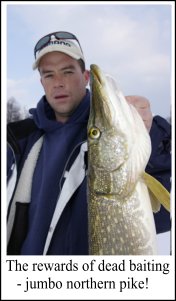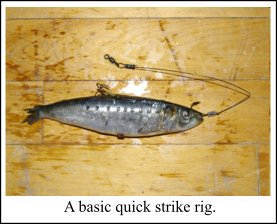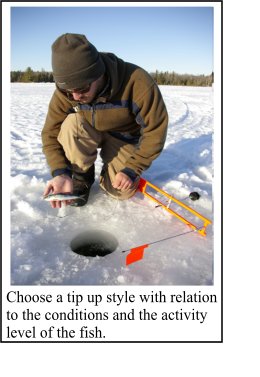|
Dead-Bait Tactics
for Hardwater Pike
By Justin Hoffman
Snow-covered
landscapes and frozen bodies of water have a deliberate way of
changing a pike anglers' methods and routines. Gone are the
oversized spinnerbaits, cranks and spoons - the familiar tools of
warm weather fishing - and out come the tip ups and quick strike
rigs. Match these up with a variety of dead baits, and you'll be
well on your way to a season full of cold days and red-hot northern
pike.
The Intricacies of
Bait
Dead bait is the preferred tool when chasing winter pike. They
represent a large, stationary profile to a hungry fish, triggering
instinctive strikes from these freshwater predators. They also
provides the perfect scent and taste attributes to attract fish,
leaving a magnetic trail washing in the water and arousing their
senses. Add to that how easy they are to handle, store and rig, and
you've got yourself a definite winner. (Besides, what's better than
Mother Nature when it comes to catching fish?)
 For choosing dead bait,
a number of criteria should be considered. Smelt, herring, sardine
and sucker all make excellent choices (please check local
regulations before using), and can be purchased either fresh or
frozen from most grocery stores. Suckers can also be caught from
local streams or rivers, and put directly in the freezer until
needed. For choosing dead bait,
a number of criteria should be considered. Smelt, herring, sardine
and sucker all make excellent choices (please check local
regulations before using), and can be purchased either fresh or
frozen from most grocery stores. Suckers can also be caught from
local streams or rivers, and put directly in the freezer until
needed.
Choose bait between six
and nine-inches in length, as this seems to be the preferred size
for pike, especially during the winter months. I prefer my baits to
be slightly frozen when hitting the ice, as it allows for easier
rigging and manipulation of the bait.
The Rig
A quick strike rig provides the perfect presentation when using dead
bait. It allows for a single hook to be placed through the lips,
while a treble hook is lightly skewered on the upper back side,
toward the tail end. (see photo)

When a pike swims with
a bait, turning it around to swallow after a short run, the hooks
will usually find a secure place at the front of the mouth on the
ensuing hookset. A No. 1 single hook coupled with a No. 4 treble
works well in most situations.
Quick strike rigs can
be purchased from tackle retailers, or designed by oneself. It can
actually make for a rewarding hobby leading up to the season, and is
inexpensive to get into.
 Tip
Up Choice Tip
Up Choice
In order to present dead bait, a high quality tip up is needed.
Regardless of the style you choose, reliance on Dacron or tip up
line, in 30 to 50-pound test strength is your best bet. I prefer a
black coloured line, as it is easier to see against the snow and
ice, especially when handlining fish in.
Smooth drags are also
imperative when chasing pike, due to the length of runs and the
speed that they can achieve. Make sure that it can run freely, with
no hesitation at all.
I rely on three models
of tip ups when heading out on the ice for pike - The Original Polar
Tip-Up, the Polar Therm Tip-Up and the Windlass Tip-Up, all
manufactured by HT Enterprises. Which I use is dependent on weather
conditions, and my perceived activity of the fish. If temperatures
are very cold, and the risk of holes freezing is severe, the Polar
Therm gets the nod. This style will insulate your hole, alleviating
any freezing issues, with the spool hidden under the water. If
temperatures are warm and fish are aggressive, the Original Polar
would be my choice. And lastly, if there is a slight breeze and the
fish have taken on lockjaw, the Windlass provides the necessary and
attractive action to trigger those strikes.
The trip mechanisms are
smooth on these units, and can be adjusted for varying degrees of
release, making them ideal choices when dealing with weighty dead
bait. Whichever tip up design you choose, make sure the spool
is filled to capacity, especially if deeper water is part of your
gameplan.
Setting Up Shop
Northern pike turn on come winter, with the first ice period often
bringing your best chance for steady action. Typical locational
spots often depend on the body of water, but include shallow and
deep weedlines, rivermouths, breaklines and flats. Pike will target
these areas in one of two ways - in a patrolling, active feeding
mode, or sulking near bottom while waiting for prey to stumble by.
Pike are typically more
aggressive when the sun is shining, and mid-morning to late
afternoon will usually see them in their hungriest disposition.
Cover a variety of areas with your tip ups when beginning the day,
from water as shallow as five-feet upwards of 30-feet (if
applicable). What you are searching for are active fish, and once
found, they will give you an idea of the precise areas to target.
Bait placement can also
be paramount to your success. I prefer to suspend dead bait just off
bottom, perhaps one to two feet at most. I find the majority of fish
(especially when dealing with skinny water) cruise "belly to the
bottom," giving bait presented in this manner the best chance for
being seen. Using electronics, such as a Vexilar, can make the
positioning of bait a breeze.
Before I place a dead
bait rig in the hole, I always make a few slashes in the skin of the
fish with a knife. This helps in releasing juices, and adds to the
attraction factor of the bait itself. Although dead bait can last a
long time under the water, rigging up fresh bait periodically
throughout the day has often brought quick results.
Dead baiting for pike
can really bring out the excitement once winter sets in. It is a
simple technique that can provide ample enjoyment, with that chance
for a true trophy fish always only a flag pop away.
Photos
by Justin Hoffman
|